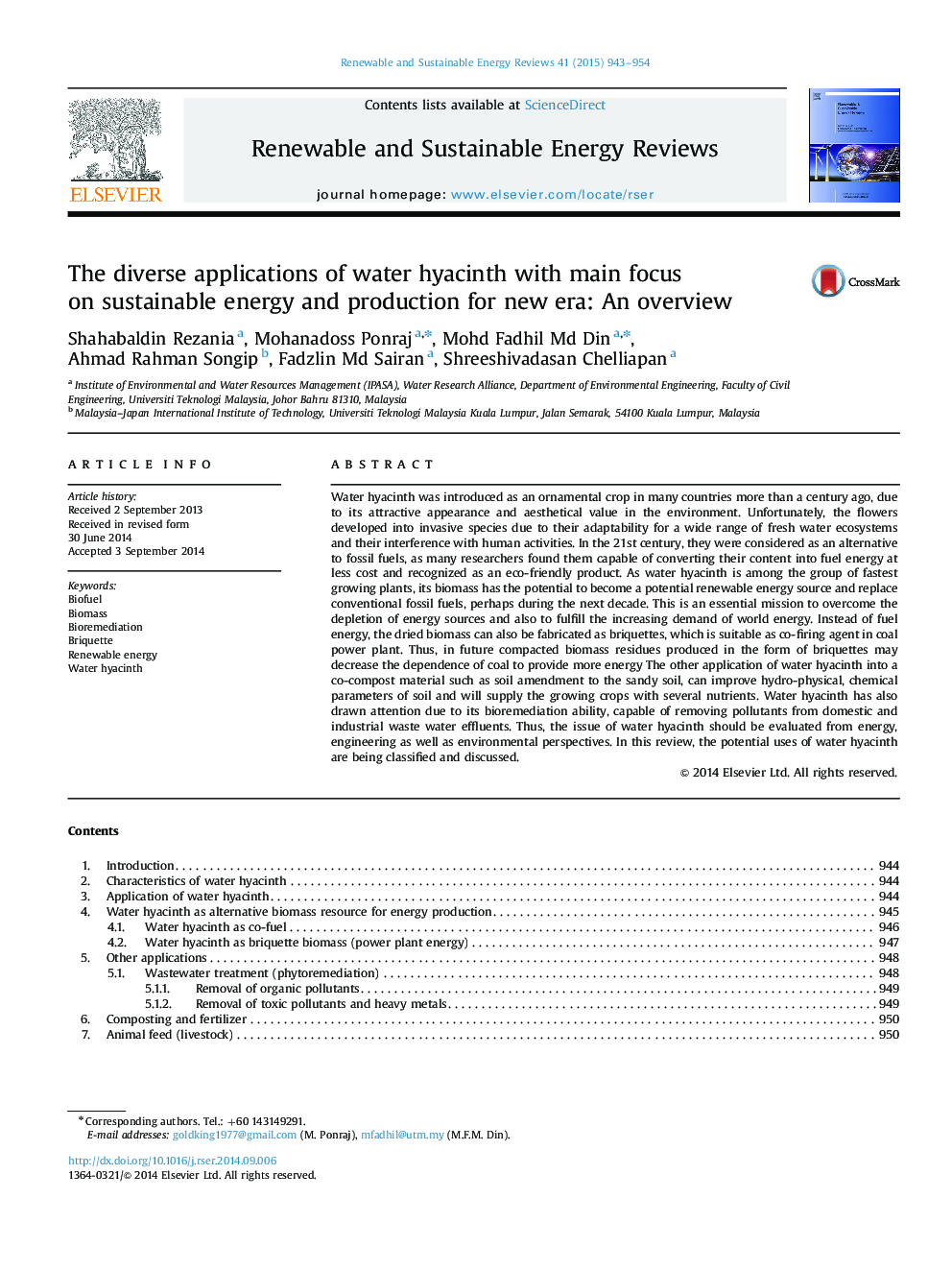| کد مقاله | کد نشریه | سال انتشار | مقاله انگلیسی | نسخه تمام متن |
|---|---|---|---|---|
| 8118694 | 1522344 | 2015 | 12 صفحه PDF | دانلود رایگان |
عنوان انگلیسی مقاله ISI
The diverse applications of water hyacinth with main focus on sustainable energy and production for new era: An overview
ترجمه فارسی عنوان
برنامه های کاربردی متنوع آب پنیر با تمرکز اصلی بر انرژی پایدار و تولید برای عصر جدید: یک مرور کلی
دانلود مقاله + سفارش ترجمه
دانلود مقاله ISI انگلیسی
رایگان برای ایرانیان
کلمات کلیدی
سوخت های زیستی، زیست توده، درمان زیستی، بریکت، انرژی تجدید پذیر، سنبلچه آب
ترجمه چکیده
بیش از یک قرن پیش، به دلیل ظاهر جذاب و ارزش زیباییشناسی در محیط، سنبله آب به عنوان یک محصول زینتی در بسیاری از کشورها به نمایش گذاشته شد. متاسفانه، گلها به دلیل سازگاری آنها با طیف وسیعی از اکوسیستم های آب شیرین و دخالت آنها در فعالیت های انسانی به گونه های مهاجم تبدیل شده اند. در قرن بیست و یکم، آنها به عنوان جایگزینی برای سوخت های فسیلی مورد توجه قرار گرفتند، زیرا بسیاری از محققان توانستند محتوای آنها را به مصرف انرژی کمتری تبدیل کنند و به عنوان یک محصول سازگار با محیط زیست شناخته شوند. به عنوان درخت جوانه زنی در میان گروهی از سریعترین گیاهان رشد می کند، زیست توده آن توانایی تبدیل شدن به یک منبع انرژی قابل تجدید را دارد و جایگزین سوخت های فسیلی معمولی می شود، شاید در دهه آینده. این یک مأموریت ضروری برای غلبه بر کمبود منابع انرژی و همچنین تحقق تقاضای روزافزون انرژی جهانی است. به جای انرژی سوخت، زیست توده خشک شده نیز می تواند به عنوان بریکت تولید شود، که به عنوان عامل شلیک در نیروگاه زغالسنگ مناسب است. بنابراین، در آینده باقی مانده زیست توده زیست توده تولید شده در قالب بریکت ممکن است وابستگی زغال سنگ را برای تولید انرژی بیشتر کاهش دهد. استفاده دیگر از سنبلچه آب به مواد کامپوزیت مانند اصلاح خاک به خاک ماسه می تواند آب آبی فیزیکی، پارامترهای شیمیایی خاک و محصولات در حال رشد با مواد مغذی متعددی عرضه می شود. جوانه زنی آب نیز به دلیل توانایی زیست محیطی آن، توجه قابل توجهی را به خود جلب کرده است که قادر به حذف آلاینده ها از پساب های خانگی و صنعتی است. بنابراین مسئله سنسورهای آبی باید از انرژی، مهندسی و همچنین چشم اندازهای محیطی ارزیابی شود. در این بررسی، استفاده بالقوه از سنبلچه آب طبقه بندی و مورد بحث قرار می گیرد.
موضوعات مرتبط
مهندسی و علوم پایه
مهندسی انرژی
انرژی های تجدید پذیر، توسعه پایدار و محیط زیست
چکیده انگلیسی
Water hyacinth was introduced as an ornamental crop in many countries more than a century ago, due to its attractive appearance and aesthetical value in the environment. Unfortunately, the flowers developed into invasive species due to their adaptability for a wide range of fresh water ecosystems and their interference with human activities. In the 21st century, they were considered as an alternative to fossil fuels, as many researchers found them capable of converting their content into fuel energy at less cost and recognized as an eco-friendly product. As water hyacinth is among the group of fastest growing plants, its biomass has the potential to become a potential renewable energy source and replace conventional fossil fuels, perhaps during the next decade. This is an essential mission to overcome the depletion of energy sources and also to fulfill the increasing demand of world energy. Instead of fuel energy, the dried biomass can also be fabricated as briquettes, which is suitable as co-firing agent in coal power plant. Thus, in future compacted biomass residues produced in the form of briquettes may decrease the dependence of coal to provide more energy The other application of water hyacinth into a co-compost material such as soil amendment to the sandy soil, can improve hydro-physical, chemical parameters of soil and will supply the growing crops with several nutrients. Water hyacinth has also drawn attention due to its bioremediation ability, capable of removing pollutants from domestic and industrial waste water effluents. Thus, the issue of water hyacinth should be evaluated from energy, engineering as well as environmental perspectives. In this review, the potential uses of water hyacinth are being classified and discussed.
ناشر
Database: Elsevier - ScienceDirect (ساینس دایرکت)
Journal: Renewable and Sustainable Energy Reviews - Volume 41, January 2015, Pages 943-954
Journal: Renewable and Sustainable Energy Reviews - Volume 41, January 2015, Pages 943-954
نویسندگان
Shahabaldin Rezania, Mohanadoss Ponraj, Mohd Fadhil Md Din, Ahmad Rahman Songip, Fadzlin Md Sairan, Shreeshivadasan Chelliapan,
